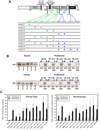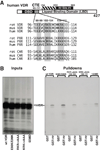Analysis of hairless corepressor mutants to characterize molecular cooperation with the vitamin D receptor in promoting the mammalian hair cycle
- PMID: 20512927
- PMCID: PMC2879709
- DOI: 10.1002/jcb.22578
Analysis of hairless corepressor mutants to characterize molecular cooperation with the vitamin D receptor in promoting the mammalian hair cycle
Abstract
The mammalian hair cycle requires both the vitamin D receptor (VDR) and the hairless (Hr) corepressor, each of which is expressed in the hair follicle. Hr interacts directly with VDR to repress VDR-targeted transcription. Herein, we further map the VDR-interaction domain to regions in the C-terminal half of Hr that contain two LXXLL-like pairs of motifs known to mediate contact of Hr with the RAR-related orphan receptor alpha and with the thyroid hormone receptor, respectively. Site-directed mutagenesis indicates that all four hydrophobic motifs are required for VDR transrepression by Hr. Point mutation of rat Hr at conserved residues corresponding to natural mutants causing alopecia in mice (G985W and a C-terminal deletion DeltaAK) and in humans (P95S, C422Y, E611G, R640Q, C642G, N988S, D1030N, A1040T, V1074M, and V1154D), as well as alteration of residues in the C-terminal Jumonji C domain implicated in histone demethylation activity (C1025G/E1027G and H1143G) revealed that all Hr mutants retained VDR association, and that transrepressor activity was selectively abrogated in C642G, G985W, N988S, D1030N, V1074M, H1143G, and V1154D. Four of these latter Hr mutants (C642G, N988S, D1030N, and V1154D) were found to associate normally with histone deacetylase-3. Finally, we identified three regions of human VDR necessary for association with Hr, namely residues 109-111, 134-201, and 202-303. It is concluded that Hr and VDR interact via multiple protein-protein interfaces, with Hr recruiting histone deacetylases and possibly itself catalyzing histone demethylation to effect chromatin remodeling and repress the transcription of VDR target genes that control the hair cycle.
(c) 2010 Wiley-Liss, Inc.
Figures








Similar articles
-
The role of vitamin D receptor mutations in the development of alopecia.Mol Cell Endocrinol. 2011 Dec 5;347(1-2):90-6. doi: 10.1016/j.mce.2011.05.045. Epub 2011 Jun 13. Mol Cell Endocrinol. 2011. PMID: 21693169 Free PMC article. Review.
-
Interactions of the vitamin D receptor with the corepressor hairless: analysis of hairless mutants in atrichia with papular lesions.J Biol Chem. 2007 Aug 31;282(35):25231-9. doi: 10.1074/jbc.M702939200. Epub 2007 Jul 3. J Biol Chem. 2007. PMID: 17609203
-
Modulation of vitamin d receptor activity by the corepressor hairless: differential effects of hairless isoforms.Endocrinology. 2009 Nov;150(11):4950-7. doi: 10.1210/en.2009-0358. Epub 2009 Oct 9. Endocrinology. 2009. PMID: 19819974 Free PMC article.
-
Physical and functional interaction between the vitamin D receptor and hairless corepressor, two proteins required for hair cycling.J Biol Chem. 2003 Oct 3;278(40):38665-74. doi: 10.1074/jbc.M304886200. Epub 2003 Jul 7. J Biol Chem. 2003. PMID: 12847098
-
Human Hairless Protein Roles in Skin/Hair and Emerging Connections to Brain and Other Cancers.J Cell Biochem. 2018 Jan;119(1):69-80. doi: 10.1002/jcb.26164. Epub 2017 Jun 14. J Cell Biochem. 2018. PMID: 28543886 Review.
Cited by
-
Characterization of hairless (Hr) and FGF5 genes provides insights into the molecular basis of hair loss in cetaceans.BMC Evol Biol. 2013 Feb 9;13:34. doi: 10.1186/1471-2148-13-34. BMC Evol Biol. 2013. PMID: 23394579 Free PMC article.
-
Vitamin D receptor-mediated control of Soggy, Wise, and Hairless gene expression in keratinocytes.J Endocrinol. 2014 Jan 8;220(2):165-78. doi: 10.1530/JOE-13-0212. Print 2014 Feb. J Endocrinol. 2014. PMID: 24190897 Free PMC article.
-
New aspects of vitamin D metabolism and action - addressing the skin as source and target.Nat Rev Endocrinol. 2020 Apr;16(4):234-252. doi: 10.1038/s41574-019-0312-5. Epub 2020 Feb 6. Nat Rev Endocrinol. 2020. PMID: 32029884 Review.
-
Hereditary Vitamin D Resistant Rickets: Clinical, Laboratory, and Genetic Characteristics of 2 Iranian Siblings.Int J Endocrinol Metab. 2017 Jul 31;15(3):e12384. doi: 10.5812/ijem.12384. eCollection 2017 Jul. Int J Endocrinol Metab. 2017. PMID: 29201067 Free PMC article.
-
The role of vitamin D receptor mutations in the development of alopecia.Mol Cell Endocrinol. 2011 Dec 5;347(1-2):90-6. doi: 10.1016/j.mce.2011.05.045. Epub 2011 Jun 13. Mol Cell Endocrinol. 2011. PMID: 21693169 Free PMC article. Review.
References
-
- Ahmad W, Faiyaz ul Haque M, Brancolini V, Tsou HC, ul Haque S, Lam H, Aita VM, Owen J, deBlaquiere M, Frank J, Cserhalmi-Friedman PB, Leask A, McGrath JA, Peacocke M, Ahmad M, Ott J, Christiano AM. Alopecia universalis associated with a mutation in the human hairless gene. Science. 1998;279:720–724. - PubMed
-
- Ahmad W, Zlotogorski A, Panteleyev AA, Lam H, Ahmad M, ul Haque MF, Abdallah HM, Dragan L, Christiano AM. Genomic organization of the human hairless gene (HR) and identification of a mutation underlying congenital atrichia in an Arab Palestinian family. Genomics. 1999;56:141–148. - PubMed
-
- Aita VM, Ahmad W, Panteleyev AA, Kozlowska U, Kozlowska A, Gilliam TC, Jablonska S, Christiano AM. A novel missense mutation (C622G) in the zinc-finger domain of the human hairless gene associated with congenital atrichia with papular lesions. Exp Dermatol. 2000;9:157–162. - PubMed
-
- Bergman R, Schein-Goldshmid R, Hochberg Z, Ben-Izhak O, Sprecher E. The alopecias associated with vitamin D-dependent rickets type IIA and with hairless gene mutations: a comparative clinical, histologic, and immunohistochemical study. Arch Dermatol. 2005;141:343–351. - PubMed
-
- Brancaz MV, Iratni R, Morrison A, Mancini SJ, Marche P, Sundberg J, Nonchev S. A new allele of the mouse hairless gene interferes with Hox/LacZ transgene regulation in hair follicle primordia. Exp Mol Pathol. 2004;76:173–181. - PubMed
Publication types
MeSH terms
Substances
Grants and funding
LinkOut - more resources
Full Text Sources

